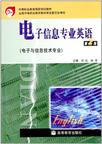电子信息专业英语
2009-5
高等教育出版社
邓红,孙萍 编
113
《电子信息专业英语》(第l版)由高等教育出版社于2002年8月正式出版,出版后受到了广大读者的欢迎。在此基础上,编者进行了第2版的修订。 本次修订,一方面保持了原有教材的风格和结构体系,另一方面也体现了以下几点修订原则。 1.扩大选材范围,适当降低难度 针对当前毕业生就业面向的是岗位群,涉及专业面广,技能要求高的特点,在选材时扩大了专业内容的范围,电工、电子、仪器设备、通信技术、计算机都有所涉及。同时撤换了一些难度较大,知识较陈旧的课文,以降低阅读理解的难度,更好地适应职业教育的特点和当前职业教育的现状。 2.进一步增强教材的实用性 在修订中,增加了与工程实践紧密结合的内容,以进一步增强教材的实用性。例如选用了元器件安全规则、焊接指导等类似工艺手册性的内容,使学生在学习专业英语的同时,能更好地学习生产实践性的专业知识,从而为更快适应将来的就业岗位打下基础。 3.增添了部分习题的解答,能更有利于师生的教与学。 本书由江苏信息职业技术学院邓红、孙萍进行修编,曹建林教授审稿。编写中难免有错误和不当之处,欢迎读者批评指出,也欢迎就本教材的编写提出意见和建议。 本书采用出版物短信防伪系统,用封底下方的防伪码,按照本书最后一页“郑重声明”下方的使用说明进行操作可查询图书真伪并赢取大奖。
《电子信息专业英语(第2版)》是中等职业教育国家规划教材,根据教育部颁布的中等职业学校电子与信息技术专业专业英语教学基本要求编写。全书共24单元,分成两大部分:前12单元为基础部分,为三、四年制共用;后12单元为提高部分,供四年制选读。教材内容涉及电路、电子技术、家用电器、通信、仪表和计算机等方面,参考了国内外较新的书刊,由浅入深,循序渐进。每课后都附有一定的练习或阅读材料,以巩固所学知识。《电子信息专业英语(第2版)》封底配有学习卡/防伪码,同时配套学习资源,按照《电子信息专业英语(第2版)》最后一页“郑重声明”下方的使用说明进行操作,便可查询图书真伪,获得相关学习资源。《电子信息专业英语(第2版)》可作为中等职业学校电子与信息技术、电子电器应用与维修等专业教材,也可作为岗位培训用书。
Lesson 1 General Electrical SystemLesson 2 Voltage, Current and PowerLesson 3 Sources of ElectricityLesson 4 Alternating CurrentLesson 5 Voltage DividersLesson 6 Diodes and Diode CircuitsLesson 7 The MOSFETLesson 8 Digital DevicesLesson 9 Digital and Analog InterfacingLesson 10 TelevisionLesson 11 ResumeLesson 12 Unsolicited Application LettersLesson 13 The Operational AmplifierLesson 14 Component Safety RulesLesson 15 Integrated CircuitLesson 16 TTL and CMOS Logic FamiliesLesson 17 Digital OscilloscopeLesson 18 Radio ReceiverLesson 19 Introduction of Optical Fiber CommunicationLesson 20 The World Wide WebLesson 21 A Computer SystemLesson 22 The Digital Signal ProcessorLesson 23 Information Technology Transforming Our SocietyLesson 24 Soldering Guide参考译文语法练习参考答案附录1 构词法附录2 专业短语参考文献
Television,or TV, the modern wonder of electronics,brings the world into your own home in sight and sound. The name television comes from the Greek word tele, meaning "far", and the Latin word videre, meaning" to see". Color TV is based on the principle of color addition. Any color can be obtained by the addition of the three primary colors, red, green and blue. When the three primary colors added together, other colors can be produced by varying the intensities of the primary colors. Let us be clear, we are not talking about painting or printing, we are talking about colored lights failing on a screen, which are additive color mixing. A color TV picture is actually a monochrome picture but with colors added for the main parts of the scene. It approximates to the process of painting color on a black and white photograph. The required color information is in the chrominance signal. To illustrate this idea of the color being in a separate signal,you can turn down the color control to eliminate the color signal, and the resuh is a black-and-white picture. The monochrome picture is produced by the luminance signal. With both the color signal and the luminance signal, the picture is reproduced in natural color. There are many schemes that have been proposed for transmission of color TV, e. g. NTSC, PAL, and SECAM. These differ in detail, but all utilize the same basic philosophy. TV is the most commonly used image communication system in the world today. However,present TV transmission Standards are based on the technology that is more than 40 years old. As a result,there has been widespread interest in the consumer electronics industry to develop more advanced TV systems that benefit from recent technological advances. Studies in the U. S. proved the feasibility of the alldigital TV, which was believed to be unrealistic not too long ago. Digital TV refers to digital representat!on and processing of the signal as well as its digital transmission.
其他版本请见:《电子信息专业英语:电子与信息技术专业(第2版)(附光盘1张)》
